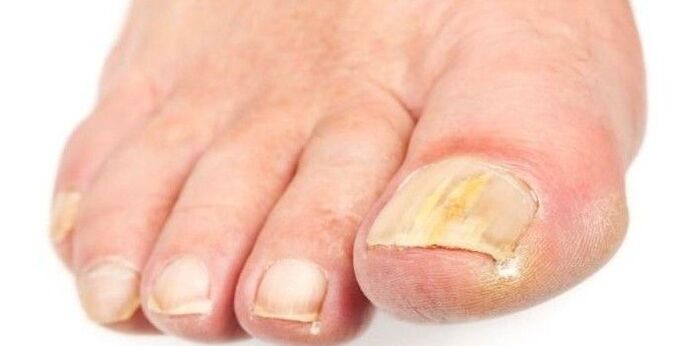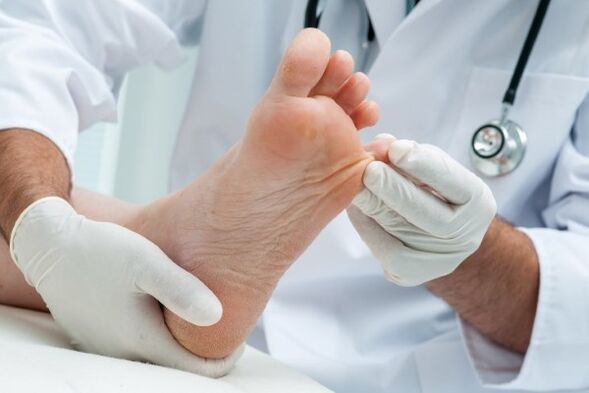Mushroom, also known as onychomycosis, is an infection of the nail surface caused by dermatophytes, yeast or mold.
The color of the nail change, first acquires whitish shades, and then darker and cannot feel bad. Playing, Deforms, starts to break up.
There is a high probability that the infection can spread to other nails on your feet and neighboring skin. The pain will appear when walking, carries shoes. Therefore, the fungus must be treated on time.
Causes of nail fungus

The causes of onnicmicosis are quite banal:
- Contact with microscopic mushrooms that are everywhere. Another question is that the nails are sensitive to infections when a person walks barefoot in humid places - pools, locker room and showers are perfect for picking up a fungus.
- Damaged nail, cracks, injured finger, infection with other bacteria or pus provide mild penetration of dermatophytes into the body.
- If a person suffers from chronic diseases, such as diabetes, peripheral vascular diseases and immunodeficiency conditions, then the candidate is class and for fungal infection on their feet.
If there were irritation, the legs sweat a lot, and the shoes are cramped and weakly ventilated with long periods of time - this is the ideal environment for the growth of the dispute.
Symptoms Fungi nail
The most common symptom caused by the Gljiva infection is the thickening of the plate. The nail can be bleached, have white, black, yellow or green.
In addition to the development of the disease becomes fragile, small pieces of nails are broken or can separate from the finger. If you don't pay due attention, the skin beneath it is swollen, it becomes painful, shell. An unpleasant odor occurs
If the disease is not done, there are usually no other symptoms. Sometimes the body can respond to a fungal in the skin without damage. A rash or itching caused by dermatophytes can be an allergic body reaction in a fungus.
Risk factors for nail development
Each person can have an infection on the finger of the leg, but there are certain risk factors that prone to infecting fungal nails. Some of them are as follows:
- Action is a prevailing risk factor for the appearance of nail fungus. When people aging, the quality of blood vessels has been reduced, and supplying blood on peripherals, which is why there is a slowdown in nail growth and general sensitivity to infections.
- The male floor is more prone to have nail fungus.
- Increased sweating, as if a person works in a damp environment, for example, erasure, washing, cleaning or cooking food.
- Carrying socks and shoes prevents the skin ventilation of legs, and synthetic material does not absorb sweat, and select cotton products.
- Bantagian risk, if you live with a person who has nail fungus - CO and you can infect.
- Walking barefoot in raw places, like a pool, gym and showers.
- Irritation between your fingers, itching, peeling, skin injury or nail, psoriasis.
- Chronic diseases, such as diabetes, peripheral vascular diseases, weak immunity and certain syndromes, such as Down syndrome.
Complications of fungi
Severe infection on the legs can be very painful and lead to constant damage to nails. If a person has a depressing immune system, diabetes or any other chronic disease, there is a high risk of complications. With diabetes, blood circulation is reduced and neuropathy often occurs. Sometimes you can't spot pain.
So not just nail fungus, but some small leg injuries can be a serious problem. If a person has diabetes, and feels there is an infection, it is reasonable to visit a doctor.
Testing and diagnostics
Infection Fungus nails are sometimes misdiagnosed as psoriasis, contact dermatitis and tumors, like melanoma. In order to avoid improper diagnosis, laboratory tests may be needed.
As a rule, three approaches are used:
- He first smeared cooked using potassium hydroxide.
- Second, it is a culture of the infectious organism.
- The third is a histological confirmation of the body.
These three approaches use microscopic studies of materials from the nails obtained by scrapers or circumcision.
According to some recent improvements, from the sensitivity point of view, the most useful direct moves, histological examination and nail plate biopsy using a spoon of periodic acid code.
In order to directly diagnose the body's organisms, several samples may be needed.
Prevention

The first step that can be taken to prevent fungal infections on the legs observes appropriate hygiene. Clean and dry legs definitely prevent any fungal infections.
Spend regularly thorough rinse with soap and don't forget to dry them after the procedure. You must wear shower slippers in public places.
You may need to change your shoes, socks and underwear more than once a day.
Improve your nail cutting technique - cut them so that nails do not cross your legs.
You may need to wear shoes that don't fit tightly towards your fingers, and their material should be such as to ensure the ventilation.
Avoid wearing cotton or woolly socks. Prefer socks made of special synthetic fibers that lead moisture from legs more efficient than cotton and wool.
Drink nails and pedicure tools. Do not use nail polish that have an infection.
When to see a doctor
It is worth scheduling with a doctor if your fungal nail infection causes the signs of bacterial: you should check the list of characters and symptoms for the correct diagnosis and proper choice of medications.
The doctor will examine the patient, listen to complaints, after which the primary tests are performed with the collection of biomaterials to determine the type of fungi. Then complete analysis of the results and purposes of therapy.
Treatment and affordable drugs
If a fungal infection is treasure, there is no need for complex treatment. However, ignoring can lead to extended to other nails. The treatment options for nail fungus are available below:
Medications are usually recommended when fungal nail infection is serious.
You may need to take the medicine for a few months so that the infection disappears. Stopping the medicine will lead to relapse too soon. Some side effects of drugs can include headaches, itching, loss of taste, nausea and diarrhea.
If a person does not want to take pills, the doctor will advise instead of using nail polish. It is not as effective as oral products, because it cannot always penetrate the nail into the focus of the infected area. Terms of use reach 12 months.
Chemical nail removal
An abnormal tracking nail can be chemically removed using a paste containing 40% urea. Pasta is easily accessible in pharmacies. You need to fasten it to your nails, cover and leave overnight. Rinse the pasta in the morning and repeat the procedure everyday. The infected plate will dissolute after about two weeks.
This is the possibility of a painless treatment that removes the patient with the knife, and also gradually removes Micoso. With such treatment, it is not necessary to take the tablets for several months, and the operation can be avoided.
Surgery and laser therapy
Surgery to remove the infected nail is recommended only in difficult conditions, if it becomes very painful, and other treatment methods did not help. After surgery, the nail will begin again, however, the year may be required for a complete recovery.
Is laser treatment a good option to relieve the nail fungus?
In the case of a stubborn nail infection, laser treatment is possible. Laser radiates high luminous energy doses, which kills and destroys mushrooms.
According to the research, laser therapy is completely safe, and the treatment rate is 90% after 3 months. However, it requires repetition every three months during the year and is not cheap.
How long can you deal with nail fungus?
Treatment of nail infection can be a long and expensive procedure.
Periral medications work on average for about four months, while the infected nail is replaced by healthy.
When using antifungal nail polish, the duration of treatment increases and can last for about a year.
Laser and surgical removal enable faster results.
















